
How to Create Awesome Book Displays
This content contains affiliate links. When you buy through these links, we may earn an affiliate commission.
I work full time at a public library, and even though I work in the Adult Reference department, I’m fortunate enough to spend most of my work hours on book-related responsibilities. But if I had to pick an area that takes up the majority of my book-related time, it would be creating library book displays. Now, for some libraries or book stores, creating displays requires nothing more than printing off a sign and slapping a few marginally-related books on a shelf and calling it a day, but that’s what separates the amateur book displays from the awesome ones.
Over the last 5+ years, my coworkers and I have devised a set of guidelines that have helped take our book displays from good to great, so strap yourselves in while I give you an inside look at how our displays are created.


 When it comes to holidays and yearly events that are standard for library displays (Valentine’s Day, Banned Books Week, Black History Month, etc.), you can make your displays stand out by giving them an unusual perspective. Do you usually put out Ireland travel guides for St. Patrick’s Day? How about a color-themed display called “It Ain’t Easy Being Green?” Or instead of doing a typical “Women’s History Month” sign for your display, call it something like “Historical Hardcore Lady Types.” It’s unexpected, it’s interesting, and it gives you an opportunity to quote Lumberjanes for work purposes.
I would also like to note that our administration has always been very supportive of our potentially controversial display topics like Pride Month and #BlackLivesMatter, so we’ve made a point to include these types of displays wherever possible throughout the year. I encourage everyone to do the same, although I know that not every administrator is willing to tackle that controversy. Make do however you can.
When it comes to holidays and yearly events that are standard for library displays (Valentine’s Day, Banned Books Week, Black History Month, etc.), you can make your displays stand out by giving them an unusual perspective. Do you usually put out Ireland travel guides for St. Patrick’s Day? How about a color-themed display called “It Ain’t Easy Being Green?” Or instead of doing a typical “Women’s History Month” sign for your display, call it something like “Historical Hardcore Lady Types.” It’s unexpected, it’s interesting, and it gives you an opportunity to quote Lumberjanes for work purposes.
I would also like to note that our administration has always been very supportive of our potentially controversial display topics like Pride Month and #BlackLivesMatter, so we’ve made a point to include these types of displays wherever possible throughout the year. I encourage everyone to do the same, although I know that not every administrator is willing to tackle that controversy. Make do however you can.

 Use multiple formats from multiple collections. Mix and match! If you have a title available in regular print, large print, and audio, put them all on there! Graphic novels? Go for it. Young adult? Related movies and documentaries? CDs? Heck, if you’re feeling adventurous, you can create book lists with relevant eBook titles and put those on display as well! Go nuts!
Use multiple formats from multiple collections. Mix and match! If you have a title available in regular print, large print, and audio, put them all on there! Graphic novels? Go for it. Young adult? Related movies and documentaries? CDs? Heck, if you’re feeling adventurous, you can create book lists with relevant eBook titles and put those on display as well! Go nuts!
 Keep an eye on condition and publication date. As much as I’d like to tell you that you can’t judge a book by its cover, the fact is that a display with newer items and eye-catching covers is going to be more enticing than a display full of banged-up books with torn covers. And as you undoubtedly know, old book covers do not always age well.
Keep an eye on condition and publication date. As much as I’d like to tell you that you can’t judge a book by its cover, the fact is that a display with newer items and eye-catching covers is going to be more enticing than a display full of banged-up books with torn covers. And as you undoubtedly know, old book covers do not always age well.
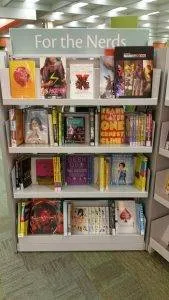
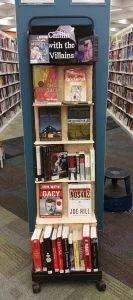
1. Brainstorm book display ideas
We have 5 different rotating displays that are changed out every 4 weeks or so. Some libraries prefer to change their displays a little more frequently, but we’ve found that this is our department sweet-spot in terms of keeping displays fresh and keeping everyone’s workload manageable. Still, that’s a lot of display ideas to cover an entire year. How do we come up with ideas? We try to have a couple display brainstorming sessions during our department meetings throughout the year, where we all come up with ideas beforehand and bring them up in the group to see what sticks. Time-sensitive displays, anytime displays, serious displays, crazy displays – nothing’s off limits here. We brainstorm based on current events, upcoming movies, buzzworthy books, historical events, even popular memes and hashtags. And we make heavy use of our current edition of Chase’s Calendar of Events. If your library or institution doesn’t have a copy, you can still get a decent list of special yearly celebrations through the free version of the Chase’s Calendar website. (Who knew that October was designated as Squirrel Awareness and Appreciation Month?!)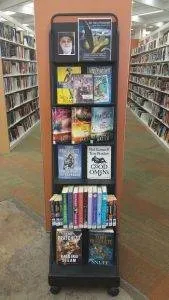 When it comes to holidays and yearly events that are standard for library displays (Valentine’s Day, Banned Books Week, Black History Month, etc.), you can make your displays stand out by giving them an unusual perspective. Do you usually put out Ireland travel guides for St. Patrick’s Day? How about a color-themed display called “It Ain’t Easy Being Green?” Or instead of doing a typical “Women’s History Month” sign for your display, call it something like “Historical Hardcore Lady Types.” It’s unexpected, it’s interesting, and it gives you an opportunity to quote Lumberjanes for work purposes.
I would also like to note that our administration has always been very supportive of our potentially controversial display topics like Pride Month and #BlackLivesMatter, so we’ve made a point to include these types of displays wherever possible throughout the year. I encourage everyone to do the same, although I know that not every administrator is willing to tackle that controversy. Make do however you can.
When it comes to holidays and yearly events that are standard for library displays (Valentine’s Day, Banned Books Week, Black History Month, etc.), you can make your displays stand out by giving them an unusual perspective. Do you usually put out Ireland travel guides for St. Patrick’s Day? How about a color-themed display called “It Ain’t Easy Being Green?” Or instead of doing a typical “Women’s History Month” sign for your display, call it something like “Historical Hardcore Lady Types.” It’s unexpected, it’s interesting, and it gives you an opportunity to quote Lumberjanes for work purposes.
I would also like to note that our administration has always been very supportive of our potentially controversial display topics like Pride Month and #BlackLivesMatter, so we’ve made a point to include these types of displays wherever possible throughout the year. I encourage everyone to do the same, although I know that not every administrator is willing to tackle that controversy. Make do however you can.
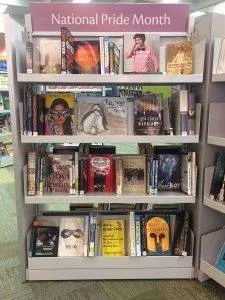
2. Select items for book displays
For most of our displays, we create material lists in our library’s catalog, then export, organize, and save the lists as Word documents so that we can reuse them in the future. But how do we decide what items should go on the display? Here are a few tips we’ve come up with. The phrase “hidden gems” should be at the forefront of every display list you put together. In bookstores, it’s common to see a ton of James Patterson and Nora Roberts novels on display because these are the big names that will drive in the big customers with the big bucks. But in libraries, we’re not so concerned with getting the big names out the door because we’re not dependent on sales and we know these big names will circulate anyway. Instead, try filling your displays with lesser-known titles, such as mid-list books, diverse authors, and #ownvoices, because these are the books your patrons are less likely to have heard about. Think outside the box! When we create displays, we try to keep a lot of the topics as broad as possible to allow for maximum creativity when picking out the titles. I particularly enjoy mixing fiction and nonfiction titles in the same display. For example, if you’re doing an adult display about space exploration, you can include books like The Martian or Saturn Run, but you can also showcase a lot of nonfiction titles as well: Hidden Figures, Welcome to the Universe, or Packing for Mars would all be excellent choices, and they’d allow you to highlight a few female authors and authors of color. Win-win!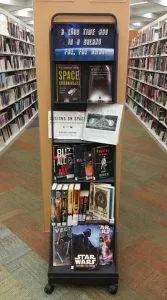 Use multiple formats from multiple collections. Mix and match! If you have a title available in regular print, large print, and audio, put them all on there! Graphic novels? Go for it. Young adult? Related movies and documentaries? CDs? Heck, if you’re feeling adventurous, you can create book lists with relevant eBook titles and put those on display as well! Go nuts!
Use multiple formats from multiple collections. Mix and match! If you have a title available in regular print, large print, and audio, put them all on there! Graphic novels? Go for it. Young adult? Related movies and documentaries? CDs? Heck, if you’re feeling adventurous, you can create book lists with relevant eBook titles and put those on display as well! Go nuts!
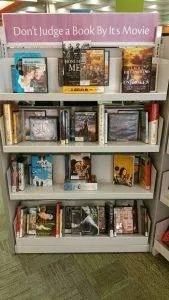 Keep an eye on condition and publication date. As much as I’d like to tell you that you can’t judge a book by its cover, the fact is that a display with newer items and eye-catching covers is going to be more enticing than a display full of banged-up books with torn covers. And as you undoubtedly know, old book covers do not always age well.
Keep an eye on condition and publication date. As much as I’d like to tell you that you can’t judge a book by its cover, the fact is that a display with newer items and eye-catching covers is going to be more enticing than a display full of banged-up books with torn covers. And as you undoubtedly know, old book covers do not always age well.
3. Put up the display
Once we’ve crafted our thoughtful display lists, we pull the items from the shelves, change their status in the catalog so that they’re listed as “display” if anyone goes looking for them, and set them up on their designated shelves. A couple of my coworkers are really good when it comes to merchandizing our displays, and I’ve picked up a couple easy techniques to maximize our shelf space and make our displays look as enticing as possible:- Face-out books are going to grab the patron’s attention, but we also shelve some of our items spine-out as well. It allows us to put more books on the shelves and makes the display look more interesting and browsable.
- Group similar items together, whether its the same book in multiple formats, or several books in a series. Stacking books is a super-easy way to do this.
- Play with angles and diagonals, if you have the shelf space and can get the books to remain upright.
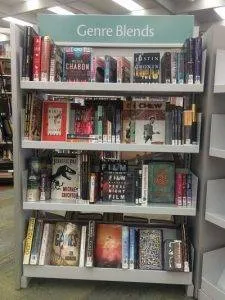

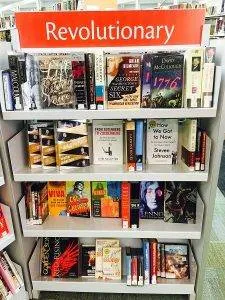 I don’t remember who set up these specific book displays, but I’ll just say it was probably one of my aforementioned coworkers. They are REALLY good at what they do! I will also note that we have a graphic designer who works at the library and creates our display signage, but this is not required to create a quality display.
At the end of the day, the best book displays are thoughtful and intentional. If you put consideration into what goes on display and how those items are arranged, your patrons will take notice too.
Got any other good display ideas? Let us know!
I don’t remember who set up these specific book displays, but I’ll just say it was probably one of my aforementioned coworkers. They are REALLY good at what they do! I will also note that we have a graphic designer who works at the library and creates our display signage, but this is not required to create a quality display.
At the end of the day, the best book displays are thoughtful and intentional. If you put consideration into what goes on display and how those items are arranged, your patrons will take notice too.
Got any other good display ideas? Let us know!












